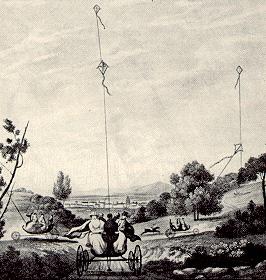charvolant.org

George Pocock, Treatise on the Aeropleustic Art, or Navigation in the Air, by means of Kites or buoyant sails, with a description of the Charvolant, or Kite Carriage, 1827Mile after mile, in succession, has been performed at the rate of twenty miles an hour, timing it by chronometer in hand. A mile has frequenty been performed, over a heavy road, in two minutes and three quarters. Let it be noticed, that the wind was not furious, neither were the kites additionally powerful for the bad state of the roads ...
That the swiftness of movement could almost prevent breathing, is certain, if going against the wind; but when travelling at such a rate, it is with the wind, and thus perfect calm is enjoyed. One evil, however, it was supposed did arise from this velocity -- loss of appetite; for one one occasion, when pulling up at a house of call seventeen miles from Bristol, some little concern was felt by the party when not one of them was disposed to take any refreshment ... However ... on looking at the chronometer, they discovered that their travelling sixteen miles within the hour: of course there could be little disposition to hunger so soon after a plentiful repast at home.
- Doug Palmer
- elements The elements object model

Terry Dowling, Blue Tyson, 1992There were heat castles over Wani when Barratin ordered the fleet in, great toppling thunderheads which crackled with heat lightning at the horizon, dwarfing the four menage charvolants and sending long trains of shadow sweeping across the land.
It was dangerous weather for charvis, what seasoned sand-ship captains called a "wired" sky. Barratin's decision was a good one. The four Exotic ships sent up fuming rooster-tails of sand, their kites bucking and plunging in the tricky thermals, and they ran for a mooring at Twilight Beach.